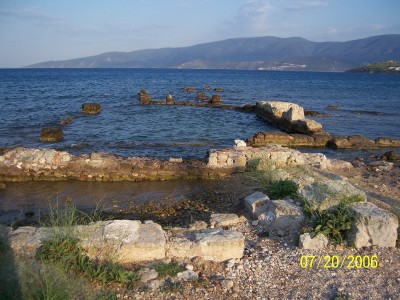|
The content on this website is maintained by
Robert Myallis, pastor at Zion's Lutheran Church, of Jonestown, PA.
The photos were taken by
Emily Myallis, a diaconal minister in the ELCA who also serves at Zion's Lutheran.
This website and travel to
Greece was made possible by a grant from the
Fund for Theological Education,
which provides grants to assist the education and formation of
Christian leaders from numerous denominations.
Bible quotes are taken from the New
Revised Standard Version, unless cites otherwise.
The above photo of Greece comes from
NASA; The icon of Saint Paul comes from George Mitrevski's website. |
 |
|
Cenchreae
 The
city of Corinth had two port cities on each side of the isthmus
(a thin strip of land separating two bodies of water). The
eastern port was called Cenchreae. The remains of the walls in
this picture come from early centers of worship at the port. The
Christian community also built a church at this port. The
city of Corinth had two port cities on each side of the isthmus
(a thin strip of land separating two bodies of water). The
eastern port was called Cenchreae. The remains of the walls in
this picture come from early centers of worship at the port. The
Christian community also built a church at this port.
How is Cenchreae significant for
understanding the world of Saint Paul?
The Bible mentions Cenchreae twice in connection with Paul.
In the middle of Acts:
After staying there for a considerable time, Paul said
farewell to the believers1 and sailed for Syria, accompanied by
Priscilla and Aquila. At Cenchreae he had his hair cut, for he
was under a vow (Chapter 18:18).
And at the end of Romans:
I commend to you our sister Phoebe, a deacon of the church at
Cenchreae, so that you may welcome her in the Lord as is fitting
for the saints, and help her in whatever she may require from
you, for she has been a benefactor of many and of myself as well
(Chapter 16:1-2).
Cenchreae, the actual port of Corinth, is one of the earliest
Christian centers of worship. The location of the church
at the port shows how trade helped spread Christianity.
Furthermore, both mentions in the Bible in relation to Cenchreae
include women, one of whom is a benefactor of the church. In the
early church, women clearly played a strong role.
source:
info on
Cenchreae: Placard at site, July 2007.
|
|



 The
city of Corinth had two port cities on each side of the isthmus
(a thin strip of land separating two bodies of water). The
eastern port was called Cenchreae. The remains of the walls in
this picture come from early centers of worship at the port. The
Christian community also built a church at this port.
The
city of Corinth had two port cities on each side of the isthmus
(a thin strip of land separating two bodies of water). The
eastern port was called Cenchreae. The remains of the walls in
this picture come from early centers of worship at the port. The
Christian community also built a church at this port.